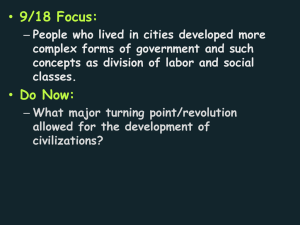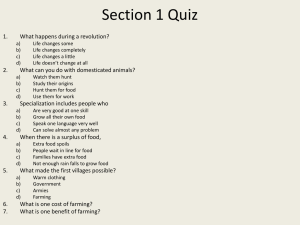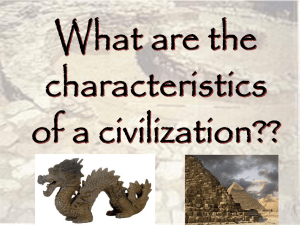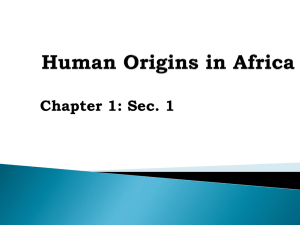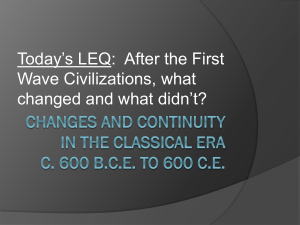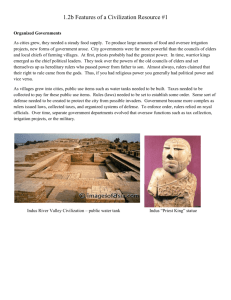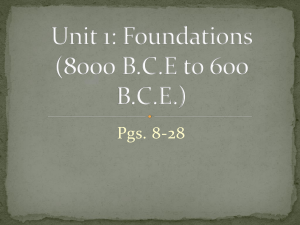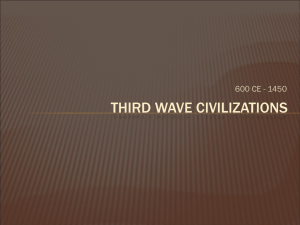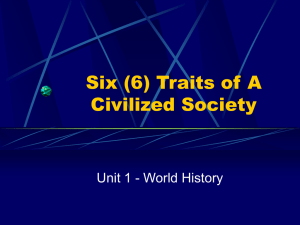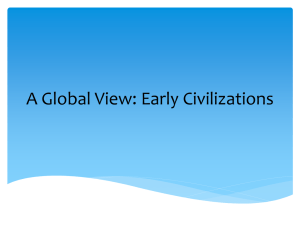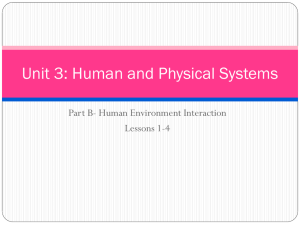Beginning of Civilization
advertisement
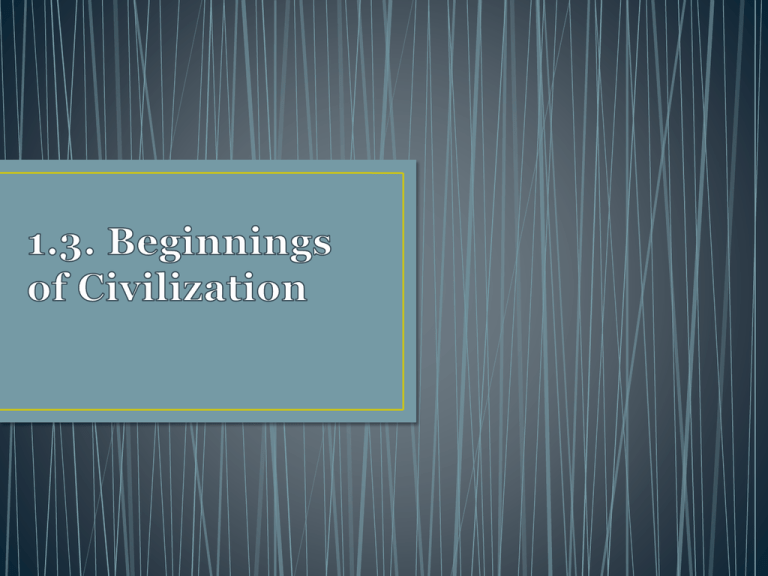
• Analyze the conditions under which the first cities and civilizations arose. • Outline the basic features that define civilization. • Understand the ways in which civilizations have changed over time. • The earliest civilizations to develop were all situated near major rivers. • These rivers provided: • Regular water supplies. • Means of transportation. • Source of food – fishing or animals that flocked to the rivers to drink. • Water for farming • Floodwater spread silt across the valleys, renewing the soil and keeping it fertile. • Silt is tiny bits of rock and dirt from the river bottom. • Farmers were able to produce surpluses of food. • These surpluses allowed them to feed growing populations and to store food for the future. • As populations expanded, some villages swelled into the world’s first cities. • In these cities some people were able to work at jobs other than farming. • The rise of cities was the main feature of civilization. • A civilization is a complex, higher organized social order. • The world’s first civilizations arose independently in a number of river valleys. • Sumer, between the Tigris and Euphrates Rivers. • Egypt along the Nile River • The Indus Civilization along the Indus River in India. • The Shang Civilization along the Huang River in China. • Unlike the first civilizations in Asia and Africa, the first civilizations in the Americas arose away from river valleys. • Major civilizations emerged in the highlands of Peru, Mexico and Central America where people learned to farm on the sides of mountains or to fill in swamps with land for farming. • Away from the first cities, many people continued to hunt, gather food, or live in farming villages. • On some less fertile lands or on sparse, dry grasslands called steppes, nomadic herder tended cattle, sheep, goats, or other animals. • Because the lands did not have abundant water or grass, these nomads had to keep moving to find new pasture. • In what ways were river valleys ideal locations for civilization to develop? • While cities are the main feature of civilizations, historians distinguish seven basic features of most early civilization. 1. 2. 3. 4. 5. 6. 7. Organized governments Complex religion Job specialization Social classes Arts and architecture Public works writing • Councils of elders or chiefs ruled many of the world’s farming villages. • In cities, more powerful organized governments arose to oversee large-scale efforts that benefited the people. • Many rulers relied on royal officials to help them govern by issuing laws, collecting taxed, and organizing systems of defense. • Overtime governments became more complex, and separate departments often evolved to oversee different functions of government. • In many early cases, priests had the greatest power in government. • In others, warrior kings emerged as the main political leaders, claiming that their right to rule come from the gods, and they passed their power from father to son. • Most ancient people were polytheistic – believed in many gods. • People appealed to sun gods, river goddesses, and other gods that they believed controlled natural forces or human activities such as birth or war. • In early religions priests and worshipers sought to gain the favor of the gods through complex rituals such as ceremonies, dances and prayers. • To ensure divine help, people built temples and sacrificed animals, crops, or sometimes other humans to the gods. • Urban people developed o many new crafts that a single individual could not master all the skills needed to make tools, weapons, or other goods. • For the first time, individuals began to specialize in certain jobs. • Some became artisans, or skilled craftspeople. • Among the crafts developed in cities, metal working was particularly important. • People learned to make tools and weapons, first out of copper and later out of bronze- a more durable mixture of copper and tin. • Bricklayers built city walls. • Soldiers defended the walls. • Merchants sold goods in the marketplace. • Such specialization made people dependent on others for their various needs. • In cities, social organization became more complex. • People were ranked according to their jobs. Such ranking led to the growth of social classes. • Priests and nobles usually occupied the top level of the ancient society. • Next came a small class of wealthy merchants. • Followed by artisans. • Below them came the vast majority of people – peasant farmers who lived in the surrounding villages and produced food for the city. • In many civilizations, slaves occupied the lower social level. Slaves sometimes came from poor families who sold family members into slavery to pay their debts. Others became slaves as punishment for crimes or were prisoners captured in war. • Because male captives were often killed, women and children made up the largest number of slaves in some societies. • The arts and architecture of ancient civilizations expressed the talents, beliefs, and values of the people who created them. • Temples and palaces often dominated the city landscapes. • Many rulers may have ordered such buildings to be constructed in order to remind people of the strength and power of their government and religion. • The skilled workers who built these massive buildings decorated them with wall paintings, statues of gods, goddesses, or rulers, and other stunning pieces of design work. • Strong rulers also ordered vast public works to be build. • Such projects included irrigation systems, roads, bridges, and defensive walls. • These public works projects were meant to benefit the city by protecting it from attack, ensuring its food supply, or enhancing the reputation of its ruler. • The projects were often quite costly, requiring a great deal of human labor and sometimes resulting in the loss of lives during construction. • The first writing systems were established in different places and at different times. In many cases with no contact among the groups who created them. • The earliest writing systems varied in appearance, structure, and purpose. • Some were used in temples, where priests needed to record amounts of grains collected, accurate information about the seasons, and precise rituals and prayers. • Others used on public monuments. • The first step people made toward developing writing was to use pictography, or simple drawings that look like the objects they represent. • Later, they developed complex writing systems including symbols that represent words, syllables, or letters. • As writing grew more complex, only specially trained people called scribes could read and write. • Scribes kept records for priests, rulers, and merchants. • Only few societies permitted women to become scribes, an occupation that could lead to political power. • Nomadic cultures different from civilizations in their social organization – that is, they did not exhibit many of the characteristics of civilizations. • The people did not build cities, and their governments were simpler. • However, nomadic people often excelled in arts and sciences. • Ancient cities changed in many ways over the centuries. • Among the chief causes of change were shifts in the physical environment and interactions among people. • People living in early civilizations depended heavily on the physical environment. • They needed ample rain and fertile soil to be able to produce crops. • Resources such as stone, timber, or metals were also essential. • Significant changes in the environment could have an immediate impact on people’s lives. • An earthquake or the eruption of a volcano could wipe out an entire civilization. • Farming the same land too much could destroy soil fertility • Rivers could become too salty. • Major source of change for people living in ancient times was culture diffusion – the spread of ideas, customs, and technologies from one people to another. • Culture diffusion occurred through migration, trade, and warfare. • As famine, drought, or other disasters led people to migrate, they interacted with others whose lives different from their own. • As a result, people often shared and adapted the customs of others. • Trade, too, introduced people to new goods or better methods of producing them. • Warfare also brought change. Often victorious armies forced their way of life upon the people they defeated. On other occasions, the victors incorporated the ways of a conquered people into their society. • As ancient rulers gained more power, they conquered territories beyond the boundaries of their cities. • This expansion led to the rise of the city-state, a politely unit that included a city and its surrounding lands and villages. • Rulers, nobles, and priests often controlled the land outside the city and forced peasants to give them some of the crops they grew on it. • In some places, significant portion of each harvest went to support the government and temples. • Rival leaders often battled for power. • Sometimes, ambitious rulers conquered many cities and villages, creating the first empires. • An empire is a group of states or territories controlled by one ruler. • What did the early civilizations have arose in different parts of the world have in common? • • • • • • • • • • • Surplus Traditional economy Civilization Steppe Polytheistic Artisan Pictograph Scribe Cultural diffusion City-state empire

